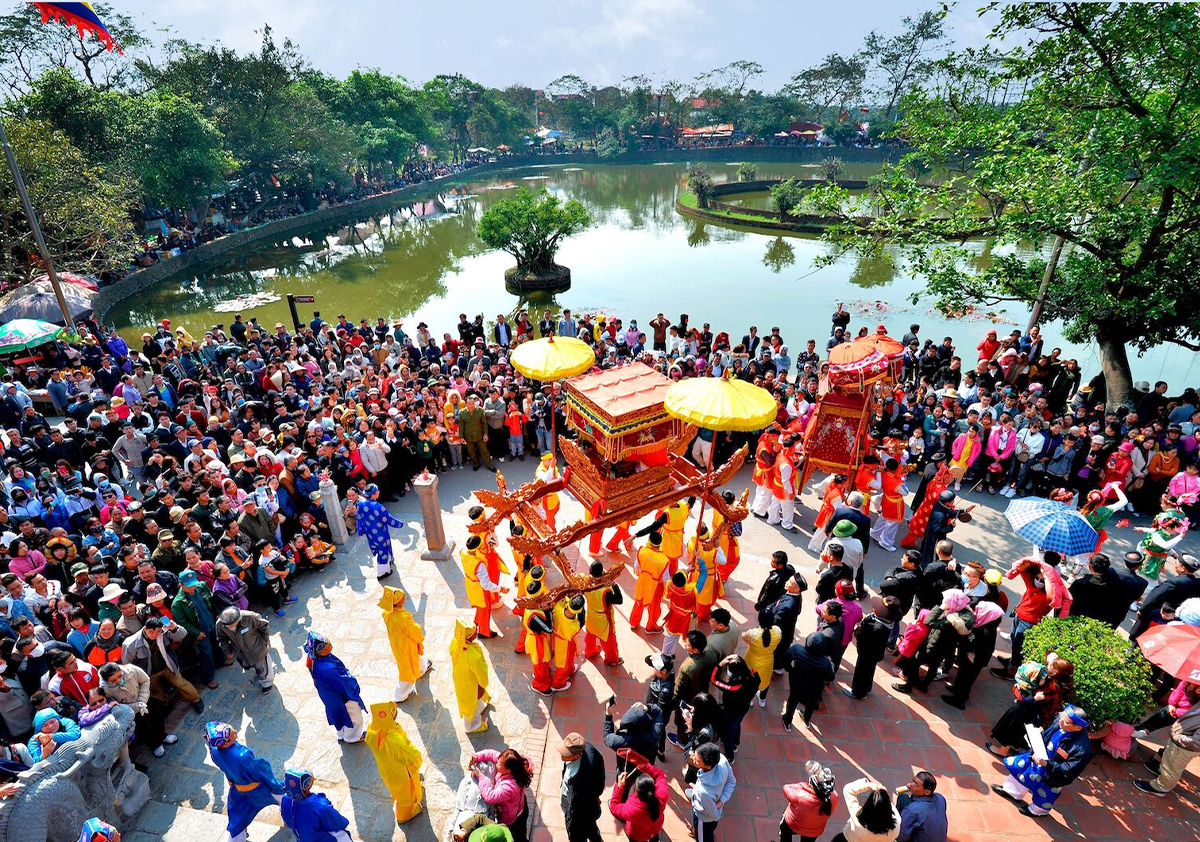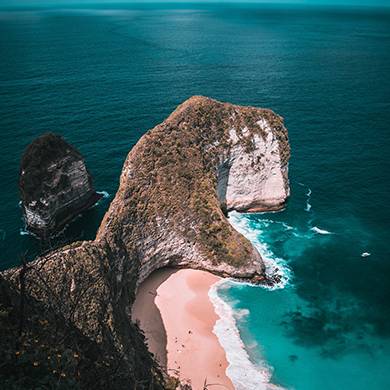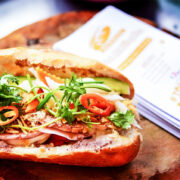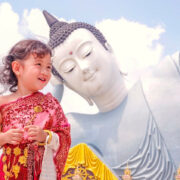
Top 12 Famous Festivals and Holidays in Vietnam
Vietnam, with its diverse culture and rich history, is a country known for its vibrant traditional festivals. Each festival serves not only as an occasion for the Vietnamese people to honor their ancestors and wish for good fortune but also as an opportunity to express their unique cultural identity. Let’s explore the Top 12 famous festivals and holidays in Vietnam with UniTourist!
Tết Nguyên Đán
Tết Nguyên Đán, also known as the Lunar New Year or Tết Ta, is the most significant holiday of the year for the Vietnamese. It marks the transition from the old year to the new, a time when people set aside the burdens of daily life to reunite with family and friends in celebration of a peaceful and prosperous year ahead.
Literally translated from Sino-Vietnamese, “Tết” means “festival,” indicating a special time of the year, while “Nguyên Đán” signifies the first day of the new year. Thus, Tết Nguyên Đán represents the moment of renewal, heralding the start of a new cycle.
For the Vietnamese, Tết is not merely a holiday; it is a cherished aspect of traditional culture. Customs such as making bánh chưng, cleaning the house, visiting relatives, and giving lucky money have become integral to Vietnamese family life. Tết is a time for descendants to express gratitude towards their ancestors and to foster closer familial bonds.
Tết is always celebrated on the first day of the first month of the lunar calendar.
Lễ Hội Lim
The Lim Festival, one of the largest and most distinctive festivals in the Kinh Bắc region, is a lively celebration of spring that brings together residents and visitors alike. Held on the 12th or 13th day of the first lunar month each year, the Lim Festival is not only a traditional cultural event but also a unique cultural experience.
The highlight of the festival is the sweet, poignant melodies of Quan Ho folk songs, performed by skilled singers on dragon boats amidst the serene lake setting, creating an enchanting and romantic musical atmosphere. The sound of the đàn tính and đàn nguyệt intertwines with traditional vocals, resulting in a unique spring symphony.
In addition to the ceremonial aspects, the Lim Festival features various recreational activities, including folk games, local delicacies, and artisan booths, all contributing to a vibrant and bustling atmosphere that attracts numerous visitors.
The Lim Festival is celebrated on the 12th or 13th day of the first lunar month.
Huế Festival and Huế Craft Village Festival
Huế, the ancient capital steeped in a thousand years of culture, is renowned not only for its majestic historical sites but also for its vibrant traditional festivals. Among them, the Huế Festival and the Huế Craft Village Festival are two cultural events that attract many domestic and international visitors.
The Huế Festival features spectacular artistic performances that recreate the glorious atmosphere of a bygone era. Traditional dances, royal court songs, áo dài fashion shows, as well as lantern contests and boat races, paint a vivid picture of the region’s cultural diversity.
In contrast, the Huế Craft Village Festival offers a rich cultural experience steeped in folk traditions. Visitors here could explore and admire unique handcrafted products, all meticulously made by skilled artisans. These items not only hold material value but also represent the essence of traditional culture.
The annual festivals in Huế are held over a week from late April to early May.
Hùng Kings’ Temple Festival
The Hùng Kings’ Temple Festival is one of the largest and most solemn festivals in Vietnam, celebrated annually to honor the contributions of the Hùng Kings in founding the nation. The Hùng Temple, located on Nghĩa Lĩnh Mountain in Phú Thọ Province, is considered the cradle of the Vietnamese people.
During the festival, thousands of people from all corners of the country flock to the temple to offer incense, pray, and participate in various traditional cultural activities. The atmosphere is both festive and reverent, featuring traditional rituals, graceful xòe dances, and sweet folk songs.
Notably, on the eve of the main festival, hundreds of lanterns are released into the sky, creating a dazzling and ethereal scene. This symbolizes the people’s hopes for a peaceful and prosperous new year.
The Hùng Kings’ Death Anniversary is observed from the 8th to the 11th day of the third lunar month.
Xến Xó Phốn Festival
Set against the majestic natural landscape of Mai Châu, the Xến Xó Phốn Festival—an extraordinary rain-seeking ritual of the White Thai people—is celebrated annually between April and May. This is one of the most unique traditional festivals of the Thai ethnic group, symbolizing a profound bond between humanity and nature.
According to Thai beliefs, rain is the source of life for all beings and is essential for bountiful harvests. Therefore, the Xến Xó Phốn Festival is held with the hope of invoking divine blessings for favorable weather and prosperous crops. During the festival, the Thai people engage in various ceremonial rites, singing traditional rain prayers, creating an atmosphere that is both solemn and sacred.
Beyond its spiritual significance, the Xến Xó Phốn Festival also serves as an occasion for the Thai community to gather and celebrate their cultural heritage. Young men and women don their vibrant traditional attire, dancing and singing together, fostering a joyful and lively atmosphere.
The Xến Xó Phốn Festival takes place in the fourth lunar month.
Vu Lan Festival
The seventh lunar month, commonly referred to as the month of wandering souls, holds special significance in Vietnamese folk beliefs. Traditionally, this is the time when spirits return to the earthly realm to visit their loved ones. Particularly on the full moon of the seventh month (Vu Lan Day), Vietnamese families conduct rituals to express their reverence for their ancestors.
On this day, families prepare elaborate offerings, light incense, and pray for the souls of the departed to find peace. Additionally, the burning of joss paper and fake money is performed with the intention of providing the deceased with essential items in the afterlife.
Vu Lan Day is not only a time for honoring ancestors but also a moment for reflection on life, aging, and mortality. It is also an occasion for family members to reunite and share cherished memories of their deceased loved ones.
The Vu Lan Festival is celebrated on the 15th day of the seventh lunar month.
National Day
On September 2nd each year, the entire nation of Vietnam joyfully commemorates National Day, a significant holiday imbued with deep historical meaning. It was on this day in 1945 that President Ho Chi Minh proclaimed the Declaration of Independence, marking the birth of the Democratic Republic of Vietnam and opening a new chapter in the nation’s history.
To honor the immense contributions of previous generations and to express deep patriotism, the Vietnamese people engage in various solemn commemorative activities. Major cities such as Hanoi and Ho Chi Minh City are festooned with the red and gold flags fluttering in the breeze. Grand ceremonies and parades are organized, attracting large crowds of participants. Notably, the dazzling fireworks display against the night sky is an iconic feature of every National Day celebration.
National Day is not only a political holiday but also a festival for the entire populace. On this day, people come together to celebrate, play, and demonstrate their spirit of unity and patriotism. Visitors also could immerse themselves in the vibrant festive atmosphere of the Vietnamese people.
Vietnam’s Independence Day is celebrated on September 2nd.
Mid-Autumn Festival
The Mid-Autumn Festival, one of the largest and most meaningful traditional celebrations for the Vietnamese, always brings joy to children. On the full moon of the eighth lunar month, children eagerly receive colorful lanterns and whimsical masks, joyfully parading with their lanterns around the neighborhood. The sounds of drumming and laughter create a lively and warm atmosphere.
Not only for children, but the Mid-Autumn Festival is also an occasion for family members to gather. Families sit around tables laden with fruit, savoring delicious mooncakes while enjoying the moonlight. The sight of the round, luminous full moon in the night sky symbolizes reunion and warmth.
Additionally, cultural and artistic activities such as lion dances and dragon dances are widely organized, capturing the interest of many. These vibrant performances not only provide joy but also contribute to preserving and promoting the traditional cultural values of the nation.
The Mid-Autumn Festival is celebrated on the 15th day of the eighth lunar month.
Oóc Om Bóc Festival
Every year, on the full moon of the tenth lunar month, the Khmer community in Southern Vietnam joyfully organizes the Oóc Om Bóc Festival—one of the largest and most distinctive traditional festivals for the Khmer people in Vietnam.
This festival is held to express gratitude to the moon god for a bountiful harvest and to pray for favorable weather in the coming year. During the festival, the Khmer participate in various cultural and sporting activities such as boat racing, releasing water lanterns, and traditional singing and dancing. Notably, the boat races are the most anticipated events, attracting large crowds of residents and visitors alike.
With its vibrant and festive atmosphere, the Oóc Om Bóc Festival not only allows the Khmer community to showcase their unique cultural identity but also serves as an opportunity for neighboring ethnic groups to mingle and learn from one another. The festival plays a significant role in promoting the beautiful image of Soc Trang’s land and people to both domestic and international friends.
The Oóc Om Bóc Festival takes place on the night of the 14th day of the tenth lunar month.
New Year’s Eve
Vietnam is one of the few countries fortunate enough to celebrate the New Year twice a year: the Lunar New Year (Tết Nguyên Đán) and the Solar New Year. This allows the Vietnamese people to experience the festive atmosphere double the time.
New Year’s Eve, especially the eve of the Lunar New Year, is the most sacred and meaningful moment of the year. Streets and roads are adorned with dazzling decorations and brilliant lights. The sounds of laughter and cheerful music blend together, creating a warm and unified atmosphere.
To fully immerse oneself in the festive spirit, visitors can head to major cities like Hanoi or Ho Chi Minh City. Here, one can join the bustling crowds, enjoy stunning fireworks displays, and partake in captivating artistic performances. Traditional dishes served during Tết, such as bánh chưng, bánh tét, and various sweet treats, will undoubtedly leave a lasting impression on visitors.
Fishermen’s Festival in Central Vietnam
As spring arrives, the coastal regions of Vietnam, particularly in the Central area, come alive with the vibrant atmosphere of the Fishermen’s Festival. This occasion allows fishermen to express their reverence to the deities, praying for a year of favorable weather, bountiful catches, and safe returns.
The festival has its roots in the worship of Ông Nam Hải, the whale, which is regarded by coastal communities as a protective deity. According to legend, whales often rescue fishermen during perilous times at sea. Thus, the Fishermen’s Festival serves not only as a time for seeking safety but also as a moment of gratitude towards these majestic creatures.
The Fishermen’s Festival is typically celebrated after the Lunar New Year, falling in March of the Gregorian calendar each year.
Lady Chúa Xứ Festival at Núi Sam
The Lady Chúa Xứ Festival at Núi Sam is one of the largest and most sacred festivals among the Vietnamese people, held annually in the fourth lunar month in An Giang Province. This festival provides an opportunity for residents to express their heartfelt reverence for Lady Chúa Xứ, while also inviting visitors from afar to explore the unique cultural beauty of the Southwestern region.
According to popular belief, Lady Chúa Xứ is a divine figure, embodying a virtuous and talented woman whom the people honor in hopes of peace and happiness. The festival serves as an occasion for the community to express gratitude to her, while praying for a year of favorable weather and prosperity.
The Oóc Om Bóc Festival is celebrated in the fourth lunar month in An Giang Province.
Recent Posts
5 banh mi stalls draw crowds at Ho Chi Minh City festival
Vietnam’s largest reclining Buddha: the icon of Som Rong Pagoda
4 Vietnamese coffees among the world’s best
Tags

Thailand





